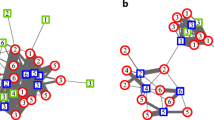Abstract
There is an established and very influential view that primate societies have identifiable, persistent social organizations. It assumes that association patterns reflect long-term strategic interests that are not qualitatively perturbed by short-term environmental variability. We used data from two baboon troops in markedly different habitats over three consecutive seasons to test this assumption. Our results demonstrate pronounced cyclicity in the extent to which females maintained differentiated relationships. When food was plentiful, the companionships identified by social network analysis in the food-scarce season disappeared and were replaced by casual acquaintanceships more representative of mere gregariousness. Data from the fourth, food-scarce, season at one site indicated that few companions were re-united. It is likely that this reflected stochastic variation in individual circumstances. These results suggest that attention could profitably be paid to the effects of short-term local contingencies on social dynamics, and has implications for current theories of primate cognitive evolution.



Similar content being viewed by others
References
Aureli F, de Waal FBM (2000) Natural conflict resolution. University of California Press, Los Angeles
Barrett L, Henzi SP (2002) Temporal constraints on relationship formation among female primates. Behaviour 139:263–289
Barrett L, Gaynor D, Henzi SP (2002) A dynamic interaction between aggression and grooming among female chacma baboons. Anim Behav 63:1047–1053
Barrett L, Henzi SP, Weingrill T, Lycett JE, Hill RA (1999) Market forces predict grooming reciprocity in female baboons. Proc Roy Soc Lond B 266:665–670
Boroditsky L (2000) Metaphoric structuring: understanding time through spatial metaphors. Cognition 75:1–28
Burnham KP, Anderson DR (1998) Model selection and inference: a practical information-theoretic approach. Springer, New York
Cohen S, Wills TA (1985) Stress, social support and the buffering hypothesis. Psych Bull 98:310–357
Cords M (1997) Friendships, alliances, reciprocity and repair. In: Whiten A, Byrne RW (eds) Machiavellian intelligence II: extensions and evaluations. Cambridge University Press, Cambridge, pp 24–49
Dunbar RIM (1992) Time: a hidden constraint on the behavioural ecology of baboons. Behav Ecol Sociobiol 31:35–49
Dunbar RIM (1998) The social brain hypothesis. Evol Anthrop 6:178–190
Efron B, Tibshirani RJ (1993) Introduction to Bootstrap. Chapman and Hall, New York
Flack JC, Girvan M, de Waal FBM, Krakauer DC (2006) Policing stabilizes construction of social niches in primates. Nature 439:426–429
Henzi SP, Barrett L (2003) Evolutionary ecology, sexual conflict and behavioral differentiation among baboon populations. Evol Anthrop 12:217–230
Henzi SP, Barrett L (2005) The historical socio-ecology of savannah baboons. J Zool 265:215–226
Henzi SP, Byrne RW, Whiten A (1992) Patterns of movement by baboons in the Drakensberg Mountains: primary responses to the environment. Int J Primatol 13:601–629
Hill RA 1999 Ecological and demographic determinants of time budgets in baboons: implications for cross-populational models of baboon socioecology. PhD thesis, University of Liverpool, UK
Hinde R (1976) Interactions, relationships and social structure. Man 11:1–17
Krause J, Croft DP, James R (2007) Social network theory in the behavioural sciences: potential applications. Behav Ecol Sociobiol 62:15–27
Krause J, Lusseau D, James R (2009) Animal social networks: an introduction. Behav Ecol Sociobiol. doi:10.1007/s00265-009-0747-0
Lusseau D, Newman M (2004) Identifying the role that animals play in their social networks. Proc Roy Soc Lond B 271:S477–S481
Mitchell JC (1969) Social Networks in Urban Situations. Manchester University Press, Manchester, UK
Myers M (1983) Space, time and the pattern of individual associations in a group-living species: sanderlings have no friends. Behav Ecol Sociobiol 12:129–134
Plotkin H (1994) Darwin machines and the nature of knowledge. Harvard University Press, Cambridge, MA
Pruetz JDV, Isbell LA (2000) Correlations of food distribution and patch size with agonistic interactions in female vervets (Chlorocebus aethiops) and patas monkeys (Erythrocebus patas) living in simple habitats. Behav Ecol Sociobiol 49:38–47
Ramos-Fernández G, Boyer D, Aureli F, Vick L (2009) Association networks in spider monkeys (Ateles geoffroyi). Behav Ecol Sociobiol. doi:10.1007/s00265-009-0719-4
van Schaik CP (1989) The ecology of social relationships amongst female primates. In: Standen V, Foley RA (eds) Comparative Socioecology: the behavioral ecology of humans and other mammals. Blackwell, Oxford, pp 195–218
Scott DW (1992) Multivariate density estimation. Theory, practice and visualization. Wiley, New York
Scott J (2000) Social network analysis. Sage, London
Shimooka Y (2003) Seasonal variation in association patterns of wild spider monkeys (Ateles belzebuth belzebuth) at La Macarena, Colombia. Primates 44:83–90
Silk J, Seyfarth RM, Cheney DL (1999) The structure of social relationships among female savannah baboons in Moremi Reserve, Botswana. Behaviour 136:679–703
Silk J, Alberts SC, Altmann J (2003) Social bonds of female baboons enhance infant survival. Science 302:1231–1234
Silk JB, Alberts SC, Altmann J (2006) Social relationships among adult female baboons (Papio cynocephalus) I. Variation in the strength of social bonds. Behav Ecol Sociobiol 61:183–195
Whitehead H (1995) Investigating structure and temporal scale in social organizations using identified individuals. Behav Ecol Sociobiol 6:199–208
Whitehead H (1999) Testing association patterns of social animals. Anim Behav 57:F26–F29
Whitehead, H (2009) SOCPROG programs: analyzing animal social structures. Behav Ecol Sociobiol. doi:10.1007/s00265-008-0697-y
Whitehead H, Dufault S (1999) Techniques for analyzing vertebrate social structure using identified individuals. Adv Stud Behav 28:33–74
Acknowledgments
We thank Cape Nature and KwaZulu-Natal Parks for research permission. K. Strier, H. Whitehead, M. Newman and D. Rendall very kindly read earlier versions, as did two referees. This research was supported by grants from the NRF (to SPH, LB), Killam Trusts (to DL) and Janggen-Pöhn-Stiftung (to TW).
Author information
Authors and Affiliations
Corresponding author
Additional information
Communicated by J. Krause
This contribution is part of the special issue “Social Networks: new perspectives” (Guest Editors: J. Krause, D. Lusseau and R. James).
Rights and permissions
About this article
Cite this article
Henzi, S.P., Lusseau, D., Weingrill, T. et al. Cyclicity in the structure of female baboon social networks. Behav Ecol Sociobiol 63, 1015–1021 (2009). https://doi.org/10.1007/s00265-009-0720-y
Received:
Revised:
Accepted:
Published:
Issue Date:
DOI: https://doi.org/10.1007/s00265-009-0720-y




